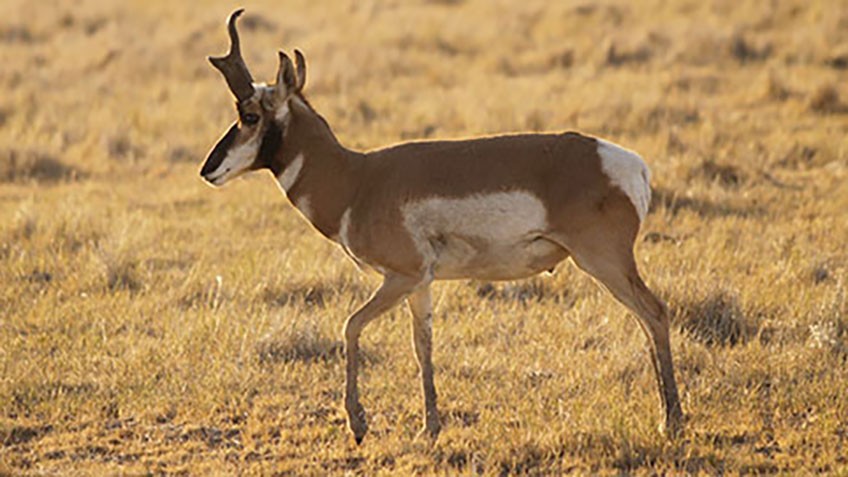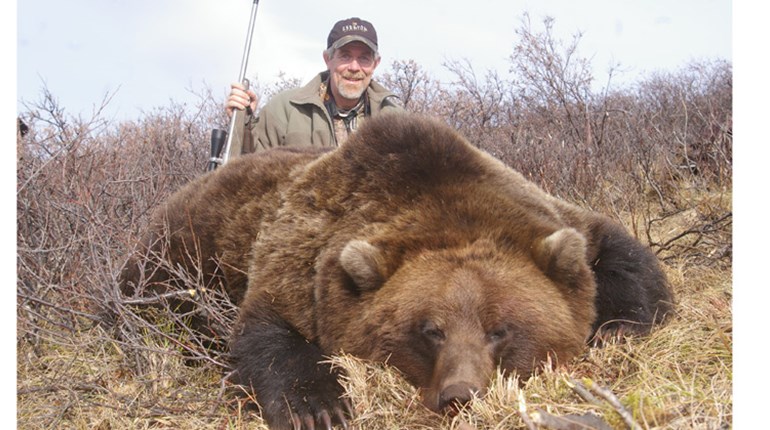
You’ve likely heard pronghorns are America’s most unique big-game animal. It’s true and not debatable based on a rocky evolutionary trail that left them the sole survivor of a group of animals that spanned a 20 million-year reign across the North American plains. Pronghorns also require a unique approach for a hunting victory on public lands. You can debate that statement, but doing so will only diminish your odds for success. Embrace it and you’ll speed along like the continent’s fastest land animal.
On one of my first hunts for the creatively camouflaged animal, I felt as if the likelihood of tagging a buck was escaping faster than a shelter dog staring at an open kennel door. Several pickup trucks arrived soon after shooting light and were driving every road in the public pasture. Their rumbling roaming stirred up the pronghorns, causing them to sprint over the nearest horizon with rumps flared, warning of danger. From a hill I observed a single herd, out of rifle range, racing toward a nearby fence. One by one they slipped under the barbed wire before kicking up dust again in true dragster fashion on the far side.
Hoping another herd would repeat the great escape, I jogged to within shooting range of the fence-line crossing location and dropped prone in the fence shadow. Minutes later I heard the reverberation of a truck requiring an Exhaust Pros visit. A herd of fleeing pronghorns raced into view seconds later. They, too, knew of the raised fence opening, and the first doe slid under the wire in record time. I eyed the buck catching up to the herd and followed it with my riflescope reticle. When the buck paused, waiting for its turn, I ended my hunt with one well-placed shot. Satisfaction swelled when I spied the truck hunters ogling me with binoculars as I tagged my respectable buck. I learned two things on that hunt: Move away from the public-land road crowd, and improvise with uniqueness whenever possible.
A Different View
Although scouting should play an integral part in any hunt, it can be challenging with pronghorns. It may appear as if the animals exhibit whitetail-like contentment in a springtime sagebrush basin, but that same area may be as empty as an August Wyoming waterhole by rifle season. The reason: relocation. Unlike whitetails that live a white-picket-fence existence with a core territory, pronghorns pattern only when conditions allow. But they have no desire to hold a permanent residence. Much of their lack of commitment can be blamed on you and hunting pressure. However, pronghorns have traveling tendencies even without an influx of orange. And even though their movement may not be a true migration every year, enough data suggests that, at least in northern tiers of their range, they make massive treks.
A recent study by Andrew Jakes, a University of Calgary doctoral aspirant, looked at the movement of pronghorns from the same viewpoint as migrating waterfowl that cross borders annually. The research revealed animals were moving more than 300 miles in a single season, including one individual that traveled from northeastern Montana to the prairies of Saskatchewan in the spring. Winter drove it back to Montana, but even farther into the south-central area of the Treasure State. That road trip tallied more than 350 miles. One professor at the University of Calgary likened the migration to that of barren-ground caribou.
Some pronghorn movement could be associated with elevation instead of cross-country jaunts. Pronghorns utilize open environments in the West, but some of those areas may lie above 8,000 feet. Cooler, autumn weather signals a time when those high-country wanderers need to begin a descent to lower, more hospitable elevations. Even in areas of Arizona, the southern tier of the pronghorn range, they’ve been documented to move 50 miles or more.
Nutrition and water also influence pronghorn movement. Primarily browsers, they nip at sagebrush, forbs and other vegetation. They flock to private hayfields, causing many a public-land hunter to curse, but grasses have little makeup in overall diet. That means large herds of livestock don’t impact grazing potential for pronghorns and vice versa.
Research also shows pronghorns rarely venture more than 4 miles from a trusted water source. They require approximately 3-4 quarts of water per day, more during intense heat and during the intensity of the rut. In the winter snow provides hydration, but during the rest of the year they have to find a working spigot.
Undoubtedly, hunting pressure also pushes pronghorns into massive resettlement missions. For opening-day success, keep tabs on the overall health of habitat where pronghorns may congregate. If you want even more assurances of a pronghorn presence during the season, consult with biologists and regional land managers. The pronghorn is a species dedicated to a specific environment, and state game-and-fish agencies can monitor populations with precision. Most have roadmaps of pronghorn movement and can help direct you to areas where pronghorns may trail as the days shorten, and hunting pressure increases.
Wyoming hunter Neal Ruebush appreciates the challenge of pursuing public-land pronghorns. And as a realty specialist for the Bureau of Land Management, he understands that all public land isn’t created equal. Despite the trials of hunting pressured pronghorns, Ruebush has consistently scored on bucks scoring 80 points and above, and most were taken with archery equipment.
“Hunting pressure moves pronghorn around in the areas I hunt compared to pronghorn that migrate from the Tetons to the Green River basin,” Ruebush says. “They group up in high-quality habitat for winter, but it’s during hunting season that they get pushed around the most, and from experience I know where they go.”
And go they do. Ruebush realizes pronghorns have the ability to pick up the slightest suspicious movement at great distances. When the hunting pressure starts, they’ll dart from suspected danger and trot at 30 mph for 2-3 miles without stopping. “They flat out will leave the country,” Ruebush says.
A Different Route
You’ve heard it before. Get ready to hear it again. Go where other public-land hunters won’t go. Since all real estate isn’t created equal, you have to be ready to adapt to the circumstances. In the eastern United States, hunters may only venture a mile from the road. In the West that increases to maybe 2 miles. But since the majority of Americans are out of shape (70 percent according to government data), you simply need to hike farther. The farther you can venture off a road, the better chance you’ll have at finding pronghorns.
Landscapes that don’t cater to road construction require a closer scrutiny as refuge for hunter-badgered animals. Pronghorns rely on their eyesight to reveal danger, and when visions of vehicles fill their orbs they rarely stay for long if bullets begin slicing the open air.
Where public land is crisscrossed with roads, as I experienced and is common on BLM tracts, you need to add ingenuity to endurance. Many areas have unlimited access, especially with the aid of ATVs. This means few areas will be off-limits. It’s up to you to find zones where pronghorns find refuge or travel with consistency.
First, find the borders. It’s true: The grass is always greener on the other side of the fence, and pronghorns follow the rule along with every other big-game species. Sometimes the grass is actually greener, as in the case of an irrigated alfalfa field, but fences also help manage public pastures. Oftentimes, public-land managers rotate pastures for grazing, and even though cattle and pronghorn have varying diets, pronghorns still may move to ungrazed areas to escape cattle and ranching, and to find untouched landscape.
Fences also distinguish borders between private and public ownership. If the hunting pressure is great on the public side, pronghorns will pack their bags and make tracks toward the private side. But remember, most private land also experiences hunting pressure from family, friends and outfitters. That means a border area could experience refugees crossing both ways depending on the day and hunting activity. Knowing exactly where those borders are is essential, as is understanding that you need public access to hunt public lands.
“Make sure there is a public access to get on public land, especially on parcels landlocked by private properties,” Ruebush says. “You need to access those areas from a county road or through an access agreement like Wyoming’s popular Hunter Management Program.”
Next, be aware of all habitats. Pronghorns have a tendency to lounge in open country, but don’t overlook the timber when hunting season starts. Despite a pronghorn’s natural history of being an open-country dweller, various regions of the West have splotches of trees within the pronghorn range. Uplifted ridges bordering basins exhibit pine coverings and north-facing slopes oftentimes exhibit cedars or junipers. Pronghorns won’t necessarily head to the forest, but they don’t have any aversions to diving into the scattered timber to escape hunting pressure below. Some larger parks and meadows in the middle of vast timber tracts even host pronghorns year-round. Don’t overlook an area just because it doesn’t fit the textbook definition of typical pronghorn country with an unobscured view.
“Pronghorn quickly move away from pressure, especially roads on public lands,” Ruebush adds. “They move to unpressured areas, out of sight of most hunters. I’ve found herds on top of mountains and down in river bottoms. You just have to find areas others overlook, and that usually means walking away from the easy-access areas.”
One of Ruebush’s most reliable public areas requires 2.5 miles of hiking to access it. Most hunters overlook it, but he always finds pronghorns hiding in plain sight once he finishes the hike. As for a pronghorn’s tendency to use its eyes for defense, Ruebush has seen exceptions to the rule. One season he watched a buck harassed by a group of hunters. Instead of running away across an open pasture, the buck dove into a canyon and started walking away, using the low terrain to hide its escape. It had no long-range perspective in the narrow canyon, so Ruebush flanked the buck from above and intercepted it farther down the canyon for an oddball ending to a public-land hunt.
One last element to watch doesn’t begin with the landscape. It starts in the sky. Watch the weather. The majority of pronghorn country is only accessible via two-track roads characterized by clay-like soil that, when wet, has the consistency of nasal discharge. Wet roads inhibit travel and could lead you to being stranded in the backcountry until the sun once again dries out the route. Few venture down such questionable trails, giving the hiking hunter a distinct advantage and a sense of appreciated loneliness on public lands. Watch the forecast and, if you have the physical abilities, take off after a downpour to hunt while others are marooned at the end of the county-maintained road.
Several years back, an out-of-state friend and I sat gloomily listening to the extended forecast of ongoing showers. He only had a few days to hunt, and the foreboding forecast overshadowed each day. With map in hand I looked for parcels that could be accessed from an improved road and yet had the qualities to attract pronghorns. With pack frames and mud boots, we slogged off the trail and into a quagmire of prairie gumbo. Slipping and sliding described the hike in, but by midday we made our way to a vast mesa with a pronghorn herd situated in the middle. Using depressions and hills, we worked to within shooting distance, and my friend tagged a nice buck. The added pack weight and long descent accentuated the slippery hike out, but the pronghorn hunt was one of my most memorable because of the added effort.
A Top-Down Approach
The majority of pronghorn hunters use one tactic: spot-and-stalk. You won’t find many stump sitters in the crowd. Maybe during archery season you will, but not after the first shot of the rifle opener. Given the vast territory pronghorns roam, the spot-and-stalk method, combined with a hint of still-hunting, makes perfect sense. What makes even more sense is to start high and locate animals at sunrise. A high vantage point provides you with an overview of where animals may be located and their general direction of travel. Throughout the day it pays to link between the highest locations available as you travel toward likely locations as noted above: fence borders, dotted timber and anything that defines rugged. Using your topo map or digitally-downloaded maps on a GPS or smart phone, you can maneuver away from roads and toward desolation … and pronghorns. Reliable digital mapping sources like OnXMaps are worth the investment to confirm boundaries and detour from roads.
OK, so all that hiking is tiresome. If you want to take a break, plan it. Don’t just stop, drop and flop into midday slumber. Plan out your stalk to find locations where sitting makes sense. Remember that fence crossing I guarded? Fences and fence crossings always seem to provide pronghorn activity. Pronghorns can leap great horizontal distances, but they remain vertically challenged. When they encounter wire they follow the barrier looking for the opening of least resistance. Broken wires, open gates and terrain features provide simple gaps for pronghorns to slip through. You never know when a fellow hunter on public or private land will push a whole herd in front of your rifle barrel along a fence line.
Water may be an archer’s savior in dry conditions, but pressured pronghorns moving around due to hunting activity also become parched. Taking a break overlooking a reservoir makes sense as a harried herd may stop for a quick fill en route to the next badlands hideout.
Lastly, be aware of the green pastures on the other side of the fence. A hayfield or crops could attract pronghorns seeking nutrition, yet the game may prefer to escape into rugged terrain on the public side of the fence. A saddle in a ridge, leading from sanctuary toward the fields, may funnel those hungry animals right into a trap.
“It’s common in pronghorn country to pay trespass fees for private-land access, but you can do your own hunt without paying,” Ruebush says. “There are plenty of pronghorn opportunities on BLM, forest service and state lands without paying. To date I’ve killed all my pronghorn on public lands and haven’t paid a trespass fee yet.”
Not too many seasons back I found myself during the last week of pronghorn season with an unfilled tag. I looked toward a public allotment for a speedy, two-day hunt. I knew the location hosted winter herds, and I figured most of the animals would be bunched at the farthest corner to dodge hunting pressure.
At sunrise it was obvious I had landed in the pronghorn parking lot. Even so, after a couple hours of glassing I couldn’t find a mature animal. Realizing that more animals could be on the opposite corner of the public tract near a private hayfield, I took off hiking in that direction.
It was a long walk, but by late afternoon I was again in the thick of a herd. Finally, I spotted a worthy candidate, so I ducked behind a ridge and made my move. My eyes were barely peeking over the horizon when, unbelievably, one of the sharp-sighted animals spotted me.
I had to act fast as the herd bunched together for flight and started to fidget. Quickly obtaining a Nikon-confirmed range of 300 yards, I settled my crosshairs on the buck’s shoulder and sent a Hornady GMX downrange. Migrating pronghorns combined with some hunting ingenuity ended my hunt for America’s most unique big-game animal.





































